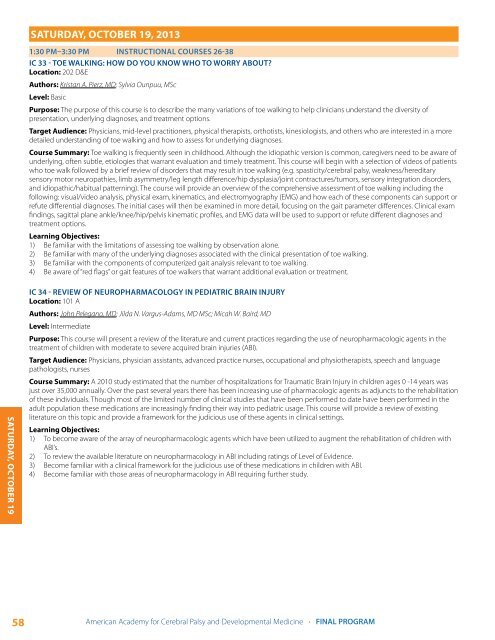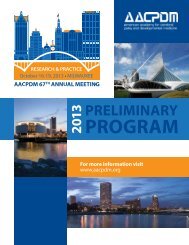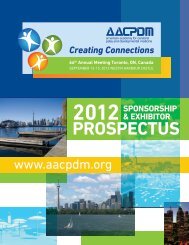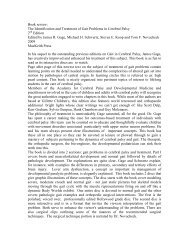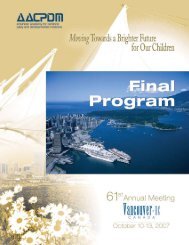ProgrAm - American Academy for Cerebral Palsy and ...
ProgrAm - American Academy for Cerebral Palsy and ...
ProgrAm - American Academy for Cerebral Palsy and ...
- No tags were found...
You also want an ePaper? Increase the reach of your titles
YUMPU automatically turns print PDFs into web optimized ePapers that Google loves.
Saturday, October 19, 20131:30 pm–3:30 pm Instructional Courses 26-38IC 33 - TOE WALKING: HOW DO YOU KNOW WHO TO WORRY ABOUT?Location: 202 D&EAuthors: Kristan A. Pierz, MD; Sylvia Ounpuu, MScLevel: BasicPurpose: The purpose of this course is to describe the many variations of toe walking to help clinicians underst<strong>and</strong> the diversity ofpresentation, underlying diagnoses, <strong>and</strong> treatment options.Target Audience: Physicians, mid-level practitioners, physical therapists, orthotists, kinesiologists, <strong>and</strong> others who are interested in a moredetailed underst<strong>and</strong>ing of toe walking <strong>and</strong> how to assess <strong>for</strong> underlying diagnoses.Course Summary: Toe walking is frequently seen in childhood. Although the idiopathic version is common, caregivers need to be aware ofunderlying, often subtle, etiologies that warrant evaluation <strong>and</strong> timely treatment. This course will begin with a selection of videos of patientswho toe walk followed by a brief review of disorders that may result in toe walking (e.g. spasticity/cerebral palsy, weakness/hereditarysensory motor neuropathies, limb asymmetry/leg length difference/hip dysplasia/joint contractures/tumors, sensory integration disorders,<strong>and</strong> idiopathic/habitual patterning). The course will provide an overview of the comprehensive assessment of toe walking including thefollowing: visual/video analysis, physical exam, kinematics, <strong>and</strong> electromyography (EMG) <strong>and</strong> how each of these components can support orrefute differential diagnoses. The initial cases will then be examined in more detail, focusing on the gait parameter differences. Clinical examfindings, sagittal plane ankle/knee/hip/pelvis kinematic profiles, <strong>and</strong> EMG data will be used to support or refute different diagnoses <strong>and</strong>treatment options.Learning Objectives:1) Be familiar with the limitations of assessing toe walking by observation alone.2) Be familiar with many of the underlying diagnoses associated with the clinical presentation of toe walking.3) Be familiar with the components of computerized gait analysis relevant to toe walking.4) Be aware of “red flags” or gait features of toe walkers that warrant additional evaluation or treatment.Saturday, October 19IC 34 - REVIEW OF NEUROPHARMACOLOGY IN PEDIATRIC BRAIN INJURYLocation: 101 AAuthors: John Pelegano, MD; Jilda N. Vargus-Adams, MD MSc; Micah W. Baird, MDLevel: IntermediatePurpose: This course will present a review of the literature <strong>and</strong> current practices regarding the use of neuropharmacologic agents in thetreatment of children with moderate to severe acquired brain injuries (ABI).Target Audience: Physicians, physician assistants, advanced practice nurses, occupational <strong>and</strong> physiotherapists, speech <strong>and</strong> languagepathologists, nursesCourse Summary: A 2010 study estimated that the number of hospitalizations <strong>for</strong> Traumatic Brain Injury in children ages 0 -14 years wasjust over 35,000 annually. Over the past several years there has been increasing use of pharmacologic agents as adjuncts to the rehabilitationof these individuals. Though most of the limited number of clinical studies that have been per<strong>for</strong>med to date have been per<strong>for</strong>med in theadult population these medications are increasingly finding their way into pediatric usage. This course will provide a review of existingliterature on this topic <strong>and</strong> provide a framework <strong>for</strong> the judicious use of these agents in clinical settings.Learning Objectives:1) To become aware of the array of neuropharmacologic agents which have been utilized to augment the rehabilitation of children withABI’s.2) To review the available literature on neuropharmacology in ABI including ratings of Level of Evidence.3) Become familiar with a clinical framework <strong>for</strong> the judicious use of these medications in children with ABI.4) Become familiar with those areas of neuropharmacology in ABI requiring further study.58<strong>American</strong> <strong>Academy</strong> <strong>for</strong> <strong>Cerebral</strong> <strong>Palsy</strong> <strong>and</strong> Developmental Medicine • FINAL PROGRAM


